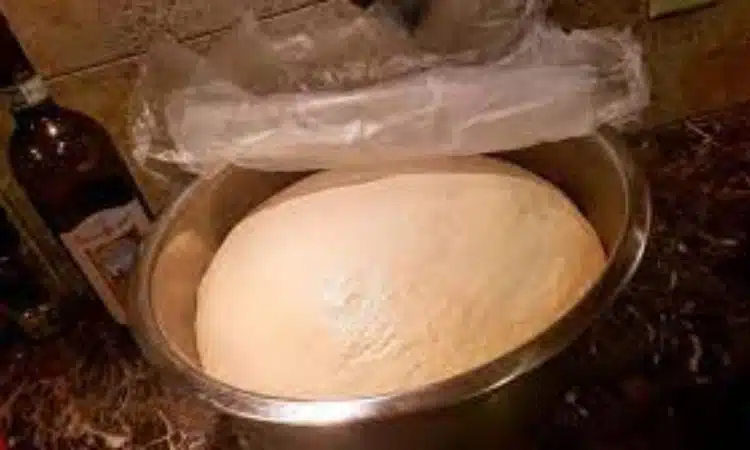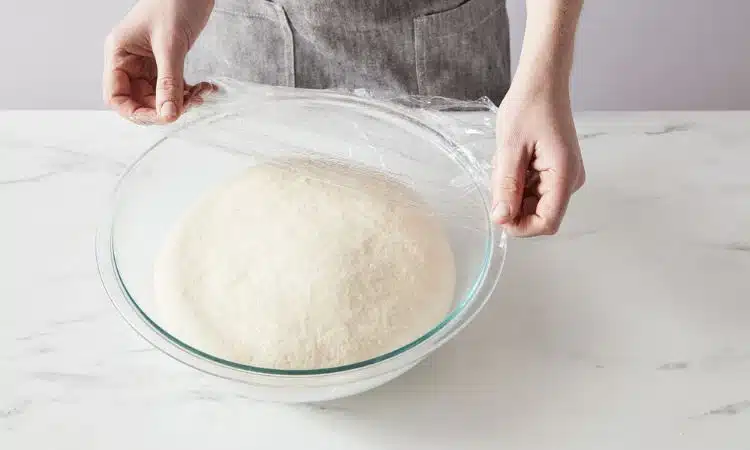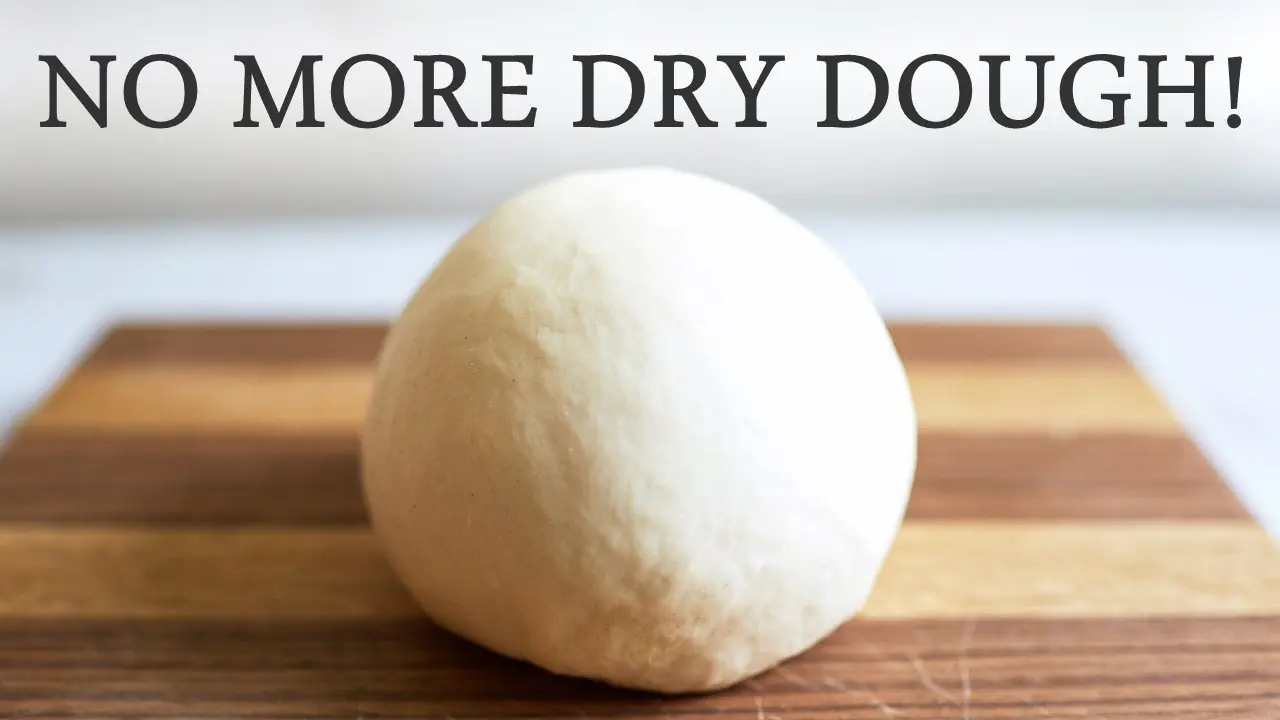When to Put Pizza Dough in Fridge: Pizza dough should be refrigerated during the cold fermentation process after initial rising. It should also be placed in the fridge when it requires slow yeast activity or overnight development.
Crafting the perfect pizza begins with mastering the art of dough preparation. Temperature control plays a crucial role in the fermentation process, influencing the dough’s flavor and texture. By moving the dough to the refrigerator, you slow down the yeast’s activity, leading to a more complex taste profile and an easily digestible crust.
This deliberate pause in dough development, known as cold fermentation, not only enhances the taste but also provides flexibility in the baking schedule. Whether you’re a home cook or a professional chef, understanding the timing for refrigerating pizza dough is key to achieving that coveted balance of crunchy crust and chewy interior in your homemade pizzas. Keep these tips in mind to ensure your pizza base is always top-notch.

The Role Of Cold Fermentation In Pizza Dough Development
Mastering the perfect pizza begins long before the oven heats up.
It starts with fermentation and knowing when to refrigerate pizza dough.
Introducing dough to a cold environment initiates cold fermentation.
This process transforms the flavor and texture of your pizza base.
Cold fermentation is like a secret ingredient.
Let’s explore how this technique can elevate your homemade pizza to pizzeria levels.
Enhancing Flavor Through Slow Yeast Activity
Slow and steady wins the flavor race in pizza dough development.
Cold fermentation takes advantage of this principle.
By slowing yeast activity, the dough develops complex flavors.
Cool temperatures in the fridge do just that.
They give yeast time to metabolize sugars without rushing the process.
- More aromatic compounds: Subtle taste notes arise.
- Depth in flavor: Hints of tang and sweetness become pronounced.
Improving Texture And Extensibility
The texture of pizza dough is crucial for a satisfying bite.
Cold fermentation plays a big part in achieving that.
During the cold rest, gluten networks strengthen.
This provides the desired chewy yet tender crust.
- Cold dough is easier to shape.
- It also stretches without tearing.
- Bubbles form evenly for consistent texture.
The dough becomes more pliable, making it easier to work with.
Yeast Dynamics: Temperature’s Impact On Dough
Understanding yeast dynamics is key to perfecting pizza dough. Yeast, a crucial ingredient, is sensitive to temperature, which can significantly influence dough behavior and quality. Temperature adjustments during fermentation can lead to different flavor profiles, textures, and readiness. Let’s delve into how temperature alters yeast activity and the resulting pros and cons of warm and cold fermentation processes.
Warm Vs. Cold Fermentation: Pros And Cons
Warm fermentation occurs at room temperature and yields dough ready for baking in a short period. It’s great for creating a dough with a pronounced yeasty flavor, and it’s ideal for certain types of bread. Conversely, cold fermentation takes place in a refrigerator, slowing yeast activity for a gradual rise. This process develops complex flavors, creating a nuanced taste profile in the dough.
| Warm Fermentation | Cold Fermentation |
| Quick rise | Slow rise |
| Strong yeasty flavor | Subtle, complex flavors |
| Softer dough texture | Chewier dough texture |
| Less planning required | Requires preparation |
How Yeast Behavior Changes With Cold Storage
Transferring pizza dough to the refrigerator (cold storage) alters yeast behavior significantly. Low temperatures slow down the yeast’s metabolism. This deceleration leads to a longer fermentation period, allowing enzymes to work on developing the dough’s flavor and structure without the rush. Cold storage can extend the dough’s life, enhance taste, and improve its handling characteristics.
- Slower gas production
- Enhanced flavor maturation
- Better texture and crust development
- Extended fermentation for scheduling flexibility
Ideal Timing For Refrigerating Pizza Dough
Getting the timing right when refrigerating pizza dough is crucial. Let’s delve into when you should shift your dough from the counter to the cooler.
Best Practices For Initial Fermentation
Initial fermentation is key. It develops flavor and texture in your dough. Follow these tips:
- Room Temperature Rise: Allow dough to rise on the countertop.
- Cover Tightly: Use plastic wrap to prevent drying.
- Temperature Check: A warm spot speeds up the process.
- Time It Right: 1 to 2 hours for a quick boost.
These steps ensure a strong start before chilling your dough.
Signs Your Dough Is Ready For The Fridge
Look for these signs to know your dough’s ready:
| Sign | Description |
| Doubled in Size | Indicates enough rise. |
| Springy Texture | It should bounce back when poked. |
| Airy Feel | Light to touch suggests fermentation success. |
These signs help ensure peak flavor and consistency.

Managing Dough Hydration And Temperature Before Chilling
Perfect pizza begins with precise dough preparation. Before refrigerating your dough, managing its hydration and temperature is crucial. This prepares the dough for optimal fermentation and flavor development. Let’s dive into how to get your dough fridge-ready!
Balancing Water Content For Optimal Refrigeration
Understanding the water content in your dough is essential. It affects both texture and taste. Ensure your dough’s hydration level is just right. Too much water results in sticky dough. Too little, and your dough becomes too dry. Aim for a soft, pliable consistency.
- Use a scale for precise measurements.
- Stick to the recommended water-to-flour ratio.
- Adjust based on feel and visual cues
Pre-cooling Strategies For Dough
To chill your dough properly, start with pre-cooling. This prevents the outside from chilling too fast. It helps maintain even fermentation throughout.
| Step | Action | Purpose |
| 1 | Let dough rest at room temperature | Kickstart fermentation |
| 2 | Place in a cool area before refrigerating | Gradually lower temperature |
| 3 | Loosely cover the dough | Prevent skin from forming |
Ensure your dough reaches a consistent temperature before placing it in the fridge. This helps the yeast work slowly and steadily. Your results? Delicious, airy crusts every time.
Maximizing Flavor: How Long To Refrigerate Dough
Let’s talk about making the dough even more delicious. Refrigerating pizza dough is a secret step to tasty pizza. It’s not just about keeping it cold. This step makes the dough flavorful. Think of it as a flavor booster. But the big question is, how long should the dough stay in the fridge? Get it right, and delight in the perfect slice of pizza.
Finding The Sweet Spot: Fermentation Duration
Fermentation is the dough’s secret to great taste. It takes time. When you put the dough in the fridge, it ferments slowly. This is the sweet spot. It works magic on the flavor. You want to aim for 24 to 72 hours. Here’s why:
- 24 Hours: It starts subtly. Flavors begin to develop.
- 48 Hours: Now we’re talking. This is richer and more complex.
- 72 Hours: If you can wait, this is the jackpot! Maximum taste.
Keep in mind that it’s flexible. Up to five days can work, but don’t push it beyond that. The dough might not agree.
The Risks Of Over-fermentation In The Fridge
Longer is only sometimes better. There’s such a thing as too much of a good thing. Over-fermentation happens when the dough overstays in the fridge. Watch out for these signs:
| Duration in Fridge | Texture | Smell |
| 5 Days | Too loose or runny | Sour or unwanted odor |
| 7 Days or More | Sticky and hard to handle | Very strong, yeasty smell |
If the dough gets too bubbly or smelly, you’ve waited too long. Aim for that 72-hour sweet spot. That’s when the flavor peaks. Longer than this, and you gamble with your perfect pizza.
Preparing Dough For Baking Post-refrigeration
Waking up your chilled pizza dough is essential for a perfect bake. Proper preparation post-refrigeration makes all the difference. Learn how to prepare your dough.
Room Temperature Recovery For Better Baking
Why let the dough sit out before baking? The answer is simple. Room-temperature dough stretches easily and cooks uniformly. Here’s how to ensure your dough is up to temp:
- Pull the dough out of the fridge for at least 30 minutes before baking.
- Place it on a countertop covered with a clean, damp cloth. Keep it cozy!
- Let the dough naturally reach room temperature. Patience is key.
Techniques For Shaping Cold Dough
Shaping cold dough can be tricky, but the right techniques turn it into child’s play. Here’s your guide to molding the perfect cold pizza base:
- Dust your surface with flour to prevent sticking.
- Gently press the dough from the center outwards, maintaining an even thickness.
- If the dough springs back, give it a rest for a few minutes and try again.
Ready, set, shape! Now your dough’s prepped, your crust will be delectable.
Storage Solutions: Keeping Dough Fresh In The Fridge
The key to a perfect pizza is fresh dough. But sometimes, life gets busy, and you have to store it for later. Don’t let that dough go bad! Learn the best ways to keep it fresh in your fridge.
Choosing The Right Container For Dough
The container you pick can make or break your dough. It should be airtight to protect the dough from fridge odors and to stop it from drying out.
Think size, too. Your dough needs space to rise. Use a container big enough to hold the dough as it doubles in size. Glass or plastic works fine. Just make sure it’s clean and food-safe.
Here are some container ideas:
- Plastic Tubes: Light and easy to store.
- Glass Bowls: See the dough rise without opening.
- Resealable Bags: Good for flat dough and saving space.
Tips To Prevent Dough From Drying Out
No one likes a dry crust. Keep that dough moist with these tips.
- Lightly oil your dough ball.
- Wrap it in cling film.
- Could you place it in an airtight container?
- Please put it in the coldest part of the fridge.
Remember: Dough loves a bit of TLC. Check on it every day. If it looks like it’s drying, add a few drops of oil and turn it to coat evenly.

Common Mistakes To Avoid With Cold Dough Fermentation
Pizza dough fermentation is as much an art as it is a science. The cold fermentation process can enhance flavor and texture. Yet, some common mistakes can spoil the result.
Incorrect Timing And Its Effect On Dough Quality
Timing is pivotal in cold fermentation. Too short, the dough won’t develop flavor. Too long, and it may overproof. This balance impacts dough quality.
Key pointers for timing:
- Less than 24 hours – insufficient fermentation.
- 24-72 hours – ideal for flavor.
- Over 72 hours – the risk of overfermentation.
Stick to recommended times for the best quality.
Avoiding Contamination: Hygiene In Dough Storage
Hygiene is crucial in preventing dough contamination. Always use clean containers and sanitize hands and surfaces before handling dough.
| Hygiene Aspect | Action Required |
| Containers | Use clean, food-safe options. |
| Hands | Wash thoroughly before handling. |
| Surfaces | Clean and disinfect prior to use. |
Implementing these steps ensures the quality and safety of your dough.
Frequently Asked Questions
Should You Refrigerate Pizza Dough Before Or After Rise?
Refrigerate pizza dough after it has risen to enhance flavor and texture. This cold fermentation process can range from a few hours to a few days.
How Long Should Pizza Dough Rest At Room Temperature?
Pizza dough should rest at room temperature for at least 30 minutes and ideally up to 2 hours before baking.
Can I Put My Dough In The Fridge After Rising?
Yes, you can refrigerate the dough after it has risen. Chill the dough to slow yeast activity and use within a few days for best results.
Should You Proof Pizza Dough In The Refrigerator?
Yes, proofing pizza dough in the refrigerator is beneficial. The cold slows fermentation, enhancing flavor and texture. Aim for a slow rise, typically 24-72 hours, for the best results.
Conclusion
Understanding the ideal timing for refrigerating pizza dough is key to baking success. Aim to cool your dough before over-rising, typically between 1 and 5 days before use. Proper chilling enhances flavor and texture. Remember, a little planning goes a long way in the art of pizza-making.
Keep experimenting and enjoy your delicious homemade creations!

As the author of the “Ultimate Pizza Guide: Recipes, Tips & Secrets Revealed,” I’m dedicated to sharing my love for pizza and empowering others to create delicious homemade pizzas with ease. Join me on a journey to uncover the secrets to perfecting your pizza game!



